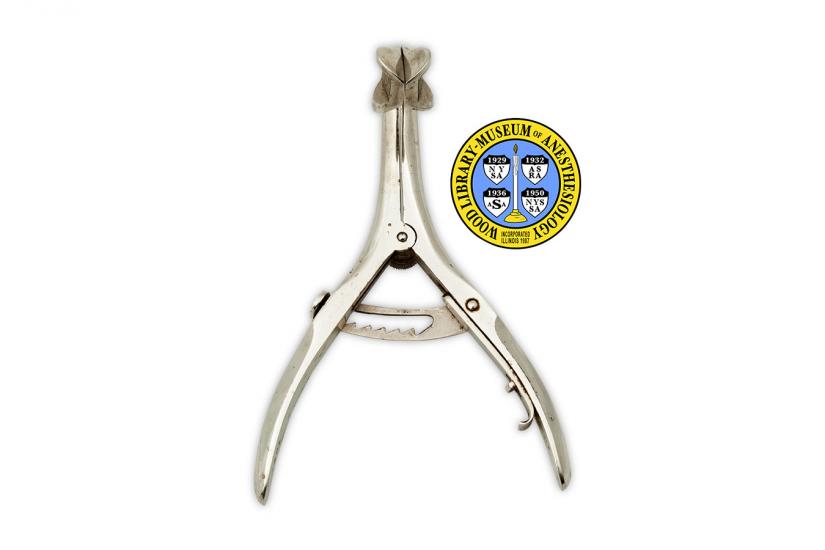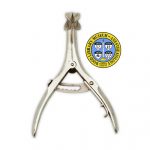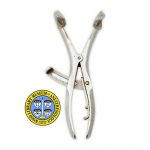Denhard Gag
Mouth gags are devices used to hold the mouth open. In medicine, they were originally used for procedures and surgery in the mouth and throat, or for opening the mouths of patients who could not do so themselves.
During anesthesia the muscles in the back of the mouth, throat and jaw relax, sometimes causing the airway to the lungs to become obstructed. Also, patients under light chloroform or ether anesthesia sometimes clenched their mouths closed. For these reasons, mouth gags were sometimes used to keep the mouth and airway open and accessible during anesthesia. Their use for this purpose waned after better anesthetics, oral airways and endotracheal tubes came into practice. However, mouth gags are still used today for procedures and surgeries involving the mouth and throat.
This mouth gag was introduced in 1887 by Dr. Chalres E. Denhard (1840-1911) of New York City. He described it as a modification of O’Dwyer’s Gag, which he felt was too easily dislodged during surgery. The arms of the gag curve sharply at the point they exit the mouth. This design ensures that the handles are located close to the side of the face, where an assistant can easily hold the gag and the patient’s head stable.
Catalog Record: Denhard Gag
Access Key: akut
Accession No.: 2010-09-23-7 E
Title: [Denhard mouth gag.]
Author: Denhard, Charles E. (Edward), 1840-1911.
Title variation: Alt Title
Title: Denhard’s modification of O’Dwyer’s gag.
Title variation: Alt Title
Title: Denhard mouth gag.
Title variation: Alt Title
Title: Denhard’s mouth gag.
Title variation: Alt Title
Title: Denhart mouth gag.
Publisher: [Place of manufacture not indicated] : [Manufacturer not indicated], [between 1887 and 1970].
Physical Descript; 1 mouth gag : metal ; 8 x 10 x 11.5 cm.
Subject: Otorhinolaryngologic Surgical Procedures – instrumentation.
Subject: Anesthesia, Dental – instrumentation.
Subject: Anesthesia, Inhalation – instrumentation.
Subject: Airway Management – instrumentation.
Subject: Airway Management Equipment.
Subject: Mouth Gags.
Note Type: General
Notes: Title based on the common name for the object.
Note Type: General
Notes: The early year (1887) in the date range for the possible year of manufacture
is based on the year that Dr. Denhard introduced the device. The end-year in
the range is an estimate. It is loosely based on the year that Dr. Revell
retired from pediatric anesthesiology, 1968. The date range could change if
documentation that indicates the dates should be corrected is discovered.
Note Type: Citation
Notes: Ball C, Westhorpe R. Clearing the airway—mouth gags, wedges and openers.
Anaesth Intensive Care. 1997;25(4):335.
Note Type: Citation
Notes: Denhard CE. A modification of O’Dwyer’s gag. Med Rec. April 23,
1887;31(17):479.
Note Type: Citation
Notes: Denhard, Charles Edward. In: Hamersly LR, ed. Who’s Who In New York City and
State. New York City: L.R. Hamersly Company; 1905:259.
Note Type: Citation
Notes: Dr. Charles E. Denhard [obituary]. Brooklyn Daily Eagle. September 29, 1911:2
https://www.newspapers.com/newspage/53900237/. Accessed April 7, 2014.
Note Type: Physical Description
Notes: One possibly nickel- or chrome-plated brass mouth gag; It has two concave
tooth-cups at the end of two sharply curved shanks that are hinged together
near the handles to form a plier-like instrument; The sharp curves ensure
that the handles sit very close to the skin on the side of the mouth; A
ratchet is riveted to the exterior of one handle and extends over a pin on
opposite handle, which acts as a catch; The ratchet terminates with a grooved
thumb-release pad; The handles are flat on interior beveled on exterior; The
measurements were taken from a patient’s perspective with the tooth-cups
completely closed, so that the handles were in their widest position; A
diagonal “RX” is stamped on the exterior of one of the handles; On a tag
written by Dr. Revell was the following description, “Side gag to hold mouth
open during oral or throat surgery, 1880s”.
Note Type: Reproduction
Notes: Photographed by Mr. Steve Donisch, September 18, 2013.
Note Type: Acquisition
Notes: Donated to the WLM by Lucien E. Morris MD. Previously owned by Daniel Revell,
MD.
Note Type: Historical
Mouth gags are devices used to hold the mouth open. In medicine, they were
originally used for procedures and surgery in the mouth and throat, or for
opening the mouths of patients who could not do so themselves.
During anesthesia the muscles in the back of the mouth, throat and jaw relax,
sometimes causing the airway to the lungs to become obstructed. Also,
patients under light chloroform or ether anesthesia sometimes clenched their
mouths closed as a normal reflex. For these reasons, mouth gags were
sometimes used to keep the mouth and airway open and accessible during
anesthesia. Their use for this purpose waned after better anesthetics, oral
airways and endotracheal tubes came into practice. However, mouth gags are
still used today for procedures and surgeries involving the mouth and throat.
This mouth gag was introduced in 1887 by Dr. Chalres E. Denhard (1840-1911)
of New York City. He described it as a modification of O’Dwyer’s Gag, which
he felt was too easily dislodged during surgery. The arms of the gag curve
sharply at the point they exit the mouth. This design ensures that the
handles are located close to the side of the face, where an assistant can
easily hold the gag and the patient’s head stable.
Note Type: Exhibition
Notes: Selected for the WLM website.



